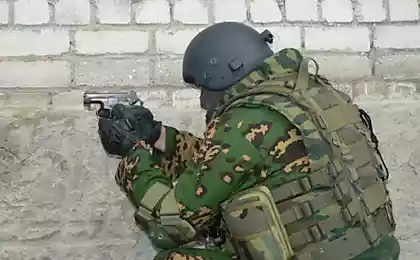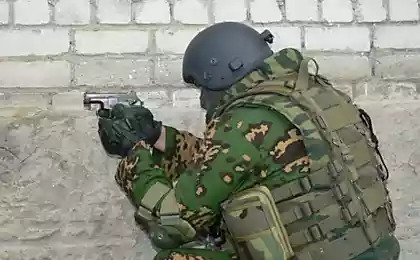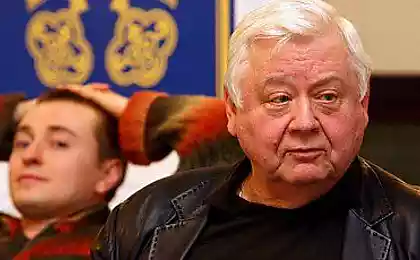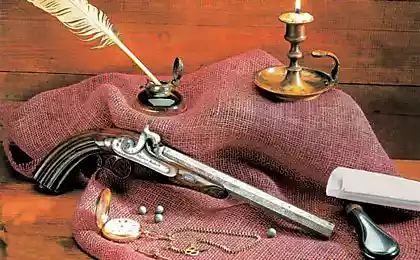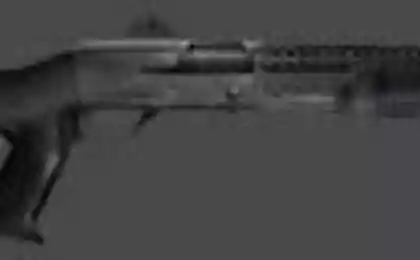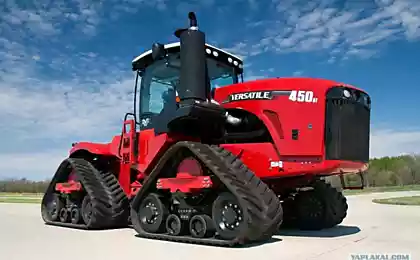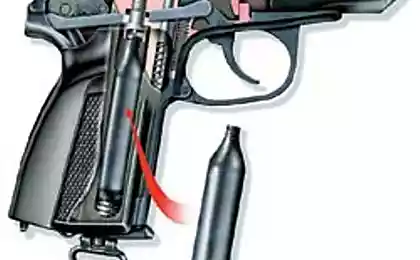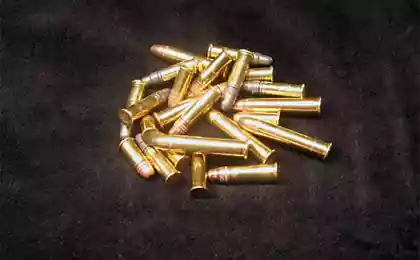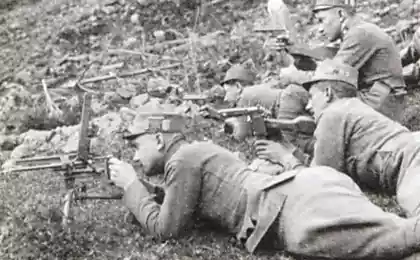1373
Pistols Russia.
Good afternoon, yapovtsy. Today I want to talk again about the weapons, and I hope it's not sink to the gun sracha.
Let's fantasize and imagine that Russia, by some miracle allowed the COP. Then what is the COP? Most likely the market of foreigners will not be allowed and will allow only domestic pistols.
But they were pretty darn small, I thought, and began to list from memory. PM, APS, Nagan, TT ... And then my knowledge of the Soviet-Russian guns run out ... oh yes ... even PMM and scribe.
I climbed to the network to see what can be when it appears on the shelves (the probability is, but there is a possibility that appears). And I was pleasantly surprised by the model number. Maybe we far from the guns of America and Europe but still. And so, I submit to your judgment and discussion of the range of our guns. By tradition, I once again cynically declare that I am a person and a person can be wrong. Therefore, if a man fumbles (convey greetings Coulter) and sees inaccuracies, correct, I will not be offended ... just a black grudge ... (just kidding).
So let us start. Will be 10 photos and some video review.
Nagant revolver
[next]
Nagant revolver, pistol - the gun, developed by Belgian gunsmiths brothers Emil (Émile) and Leon (Léon) Nagan (Nagant), was in service and is available in a number of countries in the late XIX - the middle of XX century. In the last quarter of the XIX century, many states have reflected on the rearmament of its army. By the time the most promising model of personal short firearms are guns that combined adequate simplicity of design, multiply charged and reliability. The Belgian city of Liege was one of the centers of the European arms industry. In it since 1859 there Armory Factory Emile and Leon Nagant (Fabrique d'armes Emile et Léon Nagant) - a small family workshop, remodelers Dutch revolvers and projecting their patterns of firearms. The first revolver original design elder brother Emil submitted for testing to the Belgian military, and it was adopted as the officers and noncommissioned officers' weapons called "revolver model 1878". Revolver model 1878 was a six and had a 9 mm caliber, was equipped with a "dual-action mechanism," that is cocked could be carried out directly by hand hand or automatically when you press the trigger. For non-commissioned officers of infantry, cavalry and support staff for the tasks of management of the Belgian Army model was developed with the same revolver deliberately degraded fighting qualities: by introducing further details exclude the possibility of shooting "DA mode" after each shot had to re-cocking. This variant was named "9mm revolver Nagant M / 1883." It was released a few modifications to the gun of various calibers and barrel lengths. Soon Emile Nagant due to illness is almost completely lost his sight, and major works undertaken to improve the design of Leon Nagant. Photo1

Tula Tokarev (TT)
Pistol arr. 1933 [1] (TT Tula, Tokarev, GRAU index - 56-A-132) - the first self-loading pistol Soviet Army, developed in 1930 by the Soviet designer Fyodor Vasilyevich Tokarev. TT pistol was designed for the competition in 1929 with a new army pistol, announced to replace the revolver "revolver" and several models of revolvers and pistols of foreign production, are in service with the Red Army in the mid-1920s. As a regular patron was adopted by the German cartridge 7, 63 × 25 mm Mauser, which was bought in substantial quantities for which consisted armed with pistols Mauser C-96.Po results of the tests in the competition won a TT pistol, created by the design team led by FV Tokarev Design Bureau of the Tula Arms Factory. February 12, 1931 the Revolutionary Military Council of the USSR ordered the first batch of 1,000 pistols for comprehensive military trials. In the same year Tokarev pistol was adopted by the Red Army under the official designation of "7, 62-mm automatic pistol arr. 1930 "together with the cartridge 7, 62 × 25. The gun, named TT (Tula Tokarev) was simple and technologically advanced in the production and operation. At the same time, the Soviet Union bought from the German firm "Mauser" license to produce cartridges and began production under the designation of "7, 62-mm pistol cartridge" P "arr. 1930 ". In the years 1930-1932 was released a few thousand copies. In order to improve manufacturability, in 1932-1933. Weapon undergone modernization: the lugs of the barrel is not milled and turning carried treatment; frame is made whole, without the removable lid handle; disconnector have been finalized and the shutter-release thrust. In early 1934, a new gun was accepted for service under the name "7, 62-mm automatic pistol arr. 1933 ". In 1942 it began the production of the TT at the Izhevsk Machine-Building Plant. In 1947, CT was again modified to reduce the complexity and cost of production. In the modernized version of the large vertical recesses alternating with small grooves on the housing-bolt for easy moving away housing-bolt hand back, have been replaced by small recesses (grooves). Photo 2
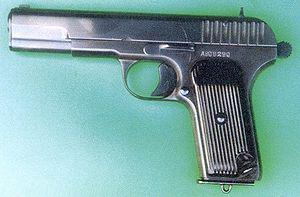
Makarov pistol
9mm Makarov pistol (PM index Grau - 56-A-125) - a self-loading [2] gun, developed by the Soviet konstruktoromtNikolaem Fedorovich Makarov in 1948. PM 1951 is a personal weapon in the Soviet and post-Soviet armed forces and law enforcement agencies. Warranty life of 4000 shots. When replacing the recoil spring, designed for 5 thousand. Shots nastrel up to 40,000 shots. In 1947-1948, the Soviet Union held a competition for a new compact pistol for senior officers of the Soviet Army. TT pistol and a revolver Nagant those already considered obsolete patterns. In addition, it was decided to enter the army two guns: a long-barreled automatic for line officers (he was an automatic pistol Stechkin) and small - and for senior officers as "weapons in peacetime." According to the contest were required to create a gun with a free gate and self-cocking trigger mechanism. As a starting point designers offers well-proven "Walther PP", manufactured since 1929. Originally required to submit two samples - in caliber 7, 65 mm and 9 mm, and later settled in the newly established 9-mm cartridge 9 × 18 mm PM, slightly more powerful (bullet energy 300 J) than the cartridge 9 × 17 mm, which was used in "Walter PP". The bullet of this cartridge has the best stopping power than a bullet cartridge 7, 62 × 25 mm TT, despite less power. Moderate capacity cartridge design allows the use of a fixed barrel and blowback. Photo 3

PMM
Externally, it features increased plastic handle a more convenient form. At the back end of the handle is made a notch for a more secure hold. MMP can be equipped with single-row magazine with 8 or 12 rounds on two-lane. Increased magazine capacity of more than 10 rounds typical for modern combat pistols. Smooth transition DIP shop at the top of the neck to the single-row are not allowed to alter the socket and store the bolt. The three helical grooves on the walls of the chamber made it possible to use high-momentum and old patrons, despite the spread of the maximum pressure of powder gases in the barrel. Cover the store extends slightly forward, which gives support to the palm and may slightly accelerate reloading. Photo 4.
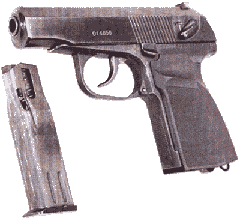
CP-1 "Gurza»
Pistola complex "Gurza" created for the special divisions of power structures and designed to engage a secure (in flak jackets 1, 2 and 3, the degree of protection) and exposed manpower, as well as various technical means (vehicles, radars, etc.) At distances up to 100 m.
The complex includes a 9-mm semi-automatic machine pistol and a specially created for him ammunition increased power 9x21 mm SP10 and SP11. Gun under the symbol RG055 developed a leading designer TSNIITOCHMASH P. Serdyukov and chief engineer Belyaev, cartridges - A. Yuryev. The gun is a melee weapon of the new generation, which is designed to reflect the latest advances in design and manufacturing of small arms of this type. Initially (from the beginning of the 1990s.) It has been developed for the Russian Army as a pistol with a large magazine capacity, and at least 50 m sighting range. After losing interest in it from the Russian Defense Ministry special services they are interested in. Such a powerful gun as "Gurza" is unusual for Russia. But he needed a Russian law enforcement agencies to deal with criminals using body armor and high-quality European cars. The first prototype of the gun "Gurza" was shown in 1991 on one of the grounds of Defense during the official competitive test pistols developed on "Rook." In 1996 he was accepted for service with the Russian special forces, called CP-1, together with specially designed cartridge pistol as part of the complex. Photo5
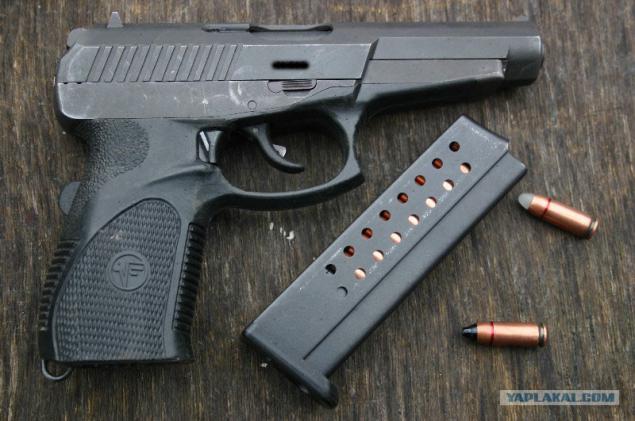
Stechkin automatic pistol
9-mm automatic pistol Stechkin (APS Index GAU - 56-A-126) - a pistol, developed in the late 1940s - nachale1950's designer IY Stechkin and adoption of the Armed Forces of the USSR in 1951, at the same time a Makarov pistol. APS is designed to arm the officers directly involved in the fighting, as well as soldiers and sergeants of some special units. Development of APS was conducted in 1948 enrolled in the same year to work in CDB-14, a young engineer Igor Yakovlevich Stechkin, and the first prototype was presented in 1949. After approval of the project, factory tests, a number of improvements and military trials, we have adopted a pistol. The weapon could fire single shots and ocheredyami.Pistolet APS intended for weapons officers, sergeants and soldiers of certain professions and crews of combat vehicles that do not rely on the state machine or a shotgun. This is rightly considered that the PM pistol is not enough for self-defense in the event of an armed clash with the enemy. Photo 6
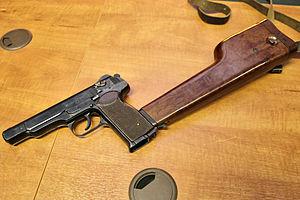
"Rook" gun 6P35 Yarygin
In the early 1990s it was finally recognized that the 9mm Makarov PM, for almost 40 years was in service with the Soviet and then Russian Army, is obsolete and needs to be replaced by more modern and powerful weapons. For adopting a new army pistol program was announced R & D (research and development activities) under the code "Rook." IMZ (IZHMEH, the main producer of Makarov PM pistol) joined the work on a new gun in 1993. The development led by the designer Vladimir Yarygin before engaged in the creation of sports pistols. During the 1990s, military requirements have changed many times, in particular, the initial requirement to adapt the pistol at once 4 patron (7.62h25mm TT 9h18mm PM 9h18mm PMM, 9x19mm) was dropped in favor of only one munition - 9mm enhanced cartridge, developed on the basis of internationally popular ammunition 9mm Luger / Parabellum. The new cartridge was developed in TSNIITOCHMASH and adopted by under the symbol 7N21. Photo7
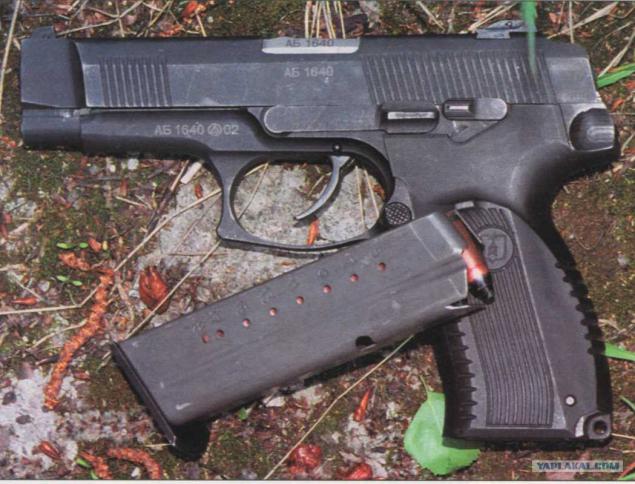
GS-18
The gun GSH-18 was developed in the late 1990s in the Tula Instrument Design Bureau under the guidance of renowned designers of weapons (mostly - aviapushek) Gryazev and Shipunova. The number 18 in the title refers to magazine capacity. KBP has begun development of a new army pistol in the mid-1990s with the creation of the 9x19mm Parabellum cartridge version with enhanced armor-piercing. Cartridge 9x19mm PBP has a light bullet with high initial rate (4.2 grams, 600 m / s) with a core of steel thermostrengthened. The first versions of pistols PMA had the designation P-96 and were not very successful, so in 1998 began developing a new gun, entered to the test in 2000. The gun, named GS-18, successfully passed the official tests and is widely advertised as for domestic consumers (mainly structures MVD, FSB, the Interior Troops), and for export sales. In connection with the adoption in Russia on arms in 2000 gun Yarigina PCOS (theme "Rook"), as well as the presence of more powerful and quite good on the characteristics of a gun Serdyukov SPS (also known as SR-1 "Vector", aka "Gurza" under 9h21mm patron SP-10). The future of gun GS-18 rather vague, though by itself it is a gun, certainly interesting, but not outstanding. Photo 8
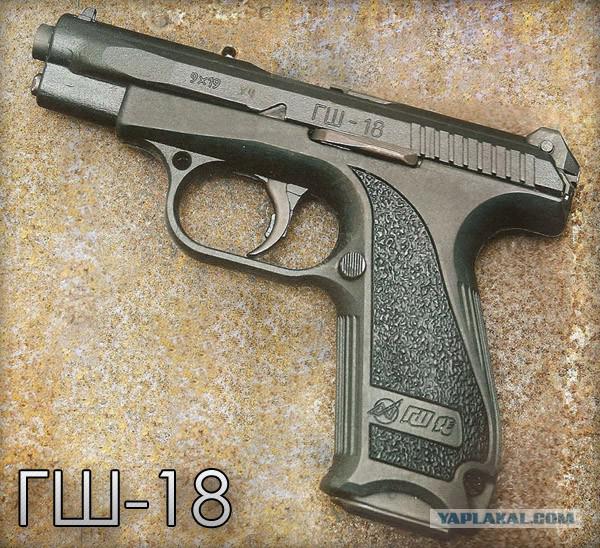
P-92
Shock - trigger double action. Trigger half-hidden, so you can quickly extract and clean the P-92 in your pocket or holster, t. To. The trigger does not cling to clothes or objects. Breakthrough powder gases when firing into the gap between the barrel and the drum is eliminated thrusting drum barrel during firing. In view of the fact that the cartridges used 9x18 PM have no side flanges, they are combined into a cage of five pieces, which also speeds up the reloading revolver. Extraction of spent cartridges at a time, in the extraction drum leans on the left side of the weapon. Thanks forward displacement of the handle accommodating the shock - trigger the gun has turned out relatively compact and lightweight. It also affected the ease of aiming and shooting from it, due to the fact that the center of mass of the gun shifted to the center. Sights not adjustable arm pads are made of plastic and have side and rear notches. Photo9
Video not found ...
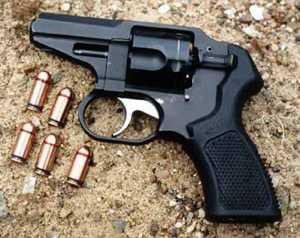
OTs-01 "Cobalt»
SAR Revolver (Revolver Stechkina - Abraham "Cobalt", also known the names of OC - 01 and TKB - 0216) The development was initiated in the early 90s designers Stechkin and Abraham, completed in late 1992. Commercially PCA "Cobalt" produced "Zlatoust Machine Building Plant" PTC "arms production." On arms of power structures of Russia is not a member. Photo10
Video not found ...
On this, I do, perhaps so as not to overload the finish information. Let's bow, your Haupman.
Attention, please just usvoyte information and are not pushed up gun sracha! Positions "WMD" and the position of "enemies of weapons" has long been clear ...

Source:
Let's fantasize and imagine that Russia, by some miracle allowed the COP. Then what is the COP? Most likely the market of foreigners will not be allowed and will allow only domestic pistols.
But they were pretty darn small, I thought, and began to list from memory. PM, APS, Nagan, TT ... And then my knowledge of the Soviet-Russian guns run out ... oh yes ... even PMM and scribe.
I climbed to the network to see what can be when it appears on the shelves (the probability is, but there is a possibility that appears). And I was pleasantly surprised by the model number. Maybe we far from the guns of America and Europe but still. And so, I submit to your judgment and discussion of the range of our guns. By tradition, I once again cynically declare that I am a person and a person can be wrong. Therefore, if a man fumbles (convey greetings Coulter) and sees inaccuracies, correct, I will not be offended ... just a black grudge ... (just kidding).
So let us start. Will be 10 photos and some video review.
Nagant revolver
[next]
Nagant revolver, pistol - the gun, developed by Belgian gunsmiths brothers Emil (Émile) and Leon (Léon) Nagan (Nagant), was in service and is available in a number of countries in the late XIX - the middle of XX century. In the last quarter of the XIX century, many states have reflected on the rearmament of its army. By the time the most promising model of personal short firearms are guns that combined adequate simplicity of design, multiply charged and reliability. The Belgian city of Liege was one of the centers of the European arms industry. In it since 1859 there Armory Factory Emile and Leon Nagant (Fabrique d'armes Emile et Léon Nagant) - a small family workshop, remodelers Dutch revolvers and projecting their patterns of firearms. The first revolver original design elder brother Emil submitted for testing to the Belgian military, and it was adopted as the officers and noncommissioned officers' weapons called "revolver model 1878". Revolver model 1878 was a six and had a 9 mm caliber, was equipped with a "dual-action mechanism," that is cocked could be carried out directly by hand hand or automatically when you press the trigger. For non-commissioned officers of infantry, cavalry and support staff for the tasks of management of the Belgian Army model was developed with the same revolver deliberately degraded fighting qualities: by introducing further details exclude the possibility of shooting "DA mode" after each shot had to re-cocking. This variant was named "9mm revolver Nagant M / 1883." It was released a few modifications to the gun of various calibers and barrel lengths. Soon Emile Nagant due to illness is almost completely lost his sight, and major works undertaken to improve the design of Leon Nagant. Photo1

Tula Tokarev (TT)
Pistol arr. 1933 [1] (TT Tula, Tokarev, GRAU index - 56-A-132) - the first self-loading pistol Soviet Army, developed in 1930 by the Soviet designer Fyodor Vasilyevich Tokarev. TT pistol was designed for the competition in 1929 with a new army pistol, announced to replace the revolver "revolver" and several models of revolvers and pistols of foreign production, are in service with the Red Army in the mid-1920s. As a regular patron was adopted by the German cartridge 7, 63 × 25 mm Mauser, which was bought in substantial quantities for which consisted armed with pistols Mauser C-96.Po results of the tests in the competition won a TT pistol, created by the design team led by FV Tokarev Design Bureau of the Tula Arms Factory. February 12, 1931 the Revolutionary Military Council of the USSR ordered the first batch of 1,000 pistols for comprehensive military trials. In the same year Tokarev pistol was adopted by the Red Army under the official designation of "7, 62-mm automatic pistol arr. 1930 "together with the cartridge 7, 62 × 25. The gun, named TT (Tula Tokarev) was simple and technologically advanced in the production and operation. At the same time, the Soviet Union bought from the German firm "Mauser" license to produce cartridges and began production under the designation of "7, 62-mm pistol cartridge" P "arr. 1930 ". In the years 1930-1932 was released a few thousand copies. In order to improve manufacturability, in 1932-1933. Weapon undergone modernization: the lugs of the barrel is not milled and turning carried treatment; frame is made whole, without the removable lid handle; disconnector have been finalized and the shutter-release thrust. In early 1934, a new gun was accepted for service under the name "7, 62-mm automatic pistol arr. 1933 ". In 1942 it began the production of the TT at the Izhevsk Machine-Building Plant. In 1947, CT was again modified to reduce the complexity and cost of production. In the modernized version of the large vertical recesses alternating with small grooves on the housing-bolt for easy moving away housing-bolt hand back, have been replaced by small recesses (grooves). Photo 2

Makarov pistol
9mm Makarov pistol (PM index Grau - 56-A-125) - a self-loading [2] gun, developed by the Soviet konstruktoromtNikolaem Fedorovich Makarov in 1948. PM 1951 is a personal weapon in the Soviet and post-Soviet armed forces and law enforcement agencies. Warranty life of 4000 shots. When replacing the recoil spring, designed for 5 thousand. Shots nastrel up to 40,000 shots. In 1947-1948, the Soviet Union held a competition for a new compact pistol for senior officers of the Soviet Army. TT pistol and a revolver Nagant those already considered obsolete patterns. In addition, it was decided to enter the army two guns: a long-barreled automatic for line officers (he was an automatic pistol Stechkin) and small - and for senior officers as "weapons in peacetime." According to the contest were required to create a gun with a free gate and self-cocking trigger mechanism. As a starting point designers offers well-proven "Walther PP", manufactured since 1929. Originally required to submit two samples - in caliber 7, 65 mm and 9 mm, and later settled in the newly established 9-mm cartridge 9 × 18 mm PM, slightly more powerful (bullet energy 300 J) than the cartridge 9 × 17 mm, which was used in "Walter PP". The bullet of this cartridge has the best stopping power than a bullet cartridge 7, 62 × 25 mm TT, despite less power. Moderate capacity cartridge design allows the use of a fixed barrel and blowback. Photo 3

PMM
Externally, it features increased plastic handle a more convenient form. At the back end of the handle is made a notch for a more secure hold. MMP can be equipped with single-row magazine with 8 or 12 rounds on two-lane. Increased magazine capacity of more than 10 rounds typical for modern combat pistols. Smooth transition DIP shop at the top of the neck to the single-row are not allowed to alter the socket and store the bolt. The three helical grooves on the walls of the chamber made it possible to use high-momentum and old patrons, despite the spread of the maximum pressure of powder gases in the barrel. Cover the store extends slightly forward, which gives support to the palm and may slightly accelerate reloading. Photo 4.

CP-1 "Gurza»
Pistola complex "Gurza" created for the special divisions of power structures and designed to engage a secure (in flak jackets 1, 2 and 3, the degree of protection) and exposed manpower, as well as various technical means (vehicles, radars, etc.) At distances up to 100 m.
The complex includes a 9-mm semi-automatic machine pistol and a specially created for him ammunition increased power 9x21 mm SP10 and SP11. Gun under the symbol RG055 developed a leading designer TSNIITOCHMASH P. Serdyukov and chief engineer Belyaev, cartridges - A. Yuryev. The gun is a melee weapon of the new generation, which is designed to reflect the latest advances in design and manufacturing of small arms of this type. Initially (from the beginning of the 1990s.) It has been developed for the Russian Army as a pistol with a large magazine capacity, and at least 50 m sighting range. After losing interest in it from the Russian Defense Ministry special services they are interested in. Such a powerful gun as "Gurza" is unusual for Russia. But he needed a Russian law enforcement agencies to deal with criminals using body armor and high-quality European cars. The first prototype of the gun "Gurza" was shown in 1991 on one of the grounds of Defense during the official competitive test pistols developed on "Rook." In 1996 he was accepted for service with the Russian special forces, called CP-1, together with specially designed cartridge pistol as part of the complex. Photo5

Stechkin automatic pistol
9-mm automatic pistol Stechkin (APS Index GAU - 56-A-126) - a pistol, developed in the late 1940s - nachale1950's designer IY Stechkin and adoption of the Armed Forces of the USSR in 1951, at the same time a Makarov pistol. APS is designed to arm the officers directly involved in the fighting, as well as soldiers and sergeants of some special units. Development of APS was conducted in 1948 enrolled in the same year to work in CDB-14, a young engineer Igor Yakovlevich Stechkin, and the first prototype was presented in 1949. After approval of the project, factory tests, a number of improvements and military trials, we have adopted a pistol. The weapon could fire single shots and ocheredyami.Pistolet APS intended for weapons officers, sergeants and soldiers of certain professions and crews of combat vehicles that do not rely on the state machine or a shotgun. This is rightly considered that the PM pistol is not enough for self-defense in the event of an armed clash with the enemy. Photo 6

"Rook" gun 6P35 Yarygin
In the early 1990s it was finally recognized that the 9mm Makarov PM, for almost 40 years was in service with the Soviet and then Russian Army, is obsolete and needs to be replaced by more modern and powerful weapons. For adopting a new army pistol program was announced R & D (research and development activities) under the code "Rook." IMZ (IZHMEH, the main producer of Makarov PM pistol) joined the work on a new gun in 1993. The development led by the designer Vladimir Yarygin before engaged in the creation of sports pistols. During the 1990s, military requirements have changed many times, in particular, the initial requirement to adapt the pistol at once 4 patron (7.62h25mm TT 9h18mm PM 9h18mm PMM, 9x19mm) was dropped in favor of only one munition - 9mm enhanced cartridge, developed on the basis of internationally popular ammunition 9mm Luger / Parabellum. The new cartridge was developed in TSNIITOCHMASH and adopted by under the symbol 7N21. Photo7

GS-18
The gun GSH-18 was developed in the late 1990s in the Tula Instrument Design Bureau under the guidance of renowned designers of weapons (mostly - aviapushek) Gryazev and Shipunova. The number 18 in the title refers to magazine capacity. KBP has begun development of a new army pistol in the mid-1990s with the creation of the 9x19mm Parabellum cartridge version with enhanced armor-piercing. Cartridge 9x19mm PBP has a light bullet with high initial rate (4.2 grams, 600 m / s) with a core of steel thermostrengthened. The first versions of pistols PMA had the designation P-96 and were not very successful, so in 1998 began developing a new gun, entered to the test in 2000. The gun, named GS-18, successfully passed the official tests and is widely advertised as for domestic consumers (mainly structures MVD, FSB, the Interior Troops), and for export sales. In connection with the adoption in Russia on arms in 2000 gun Yarigina PCOS (theme "Rook"), as well as the presence of more powerful and quite good on the characteristics of a gun Serdyukov SPS (also known as SR-1 "Vector", aka "Gurza" under 9h21mm patron SP-10). The future of gun GS-18 rather vague, though by itself it is a gun, certainly interesting, but not outstanding. Photo 8

P-92
Shock - trigger double action. Trigger half-hidden, so you can quickly extract and clean the P-92 in your pocket or holster, t. To. The trigger does not cling to clothes or objects. Breakthrough powder gases when firing into the gap between the barrel and the drum is eliminated thrusting drum barrel during firing. In view of the fact that the cartridges used 9x18 PM have no side flanges, they are combined into a cage of five pieces, which also speeds up the reloading revolver. Extraction of spent cartridges at a time, in the extraction drum leans on the left side of the weapon. Thanks forward displacement of the handle accommodating the shock - trigger the gun has turned out relatively compact and lightweight. It also affected the ease of aiming and shooting from it, due to the fact that the center of mass of the gun shifted to the center. Sights not adjustable arm pads are made of plastic and have side and rear notches. Photo9
Video not found ...

OTs-01 "Cobalt»
SAR Revolver (Revolver Stechkina - Abraham "Cobalt", also known the names of OC - 01 and TKB - 0216) The development was initiated in the early 90s designers Stechkin and Abraham, completed in late 1992. Commercially PCA "Cobalt" produced "Zlatoust Machine Building Plant" PTC "arms production." On arms of power structures of Russia is not a member. Photo10
Video not found ...
On this, I do, perhaps so as not to overload the finish information. Let's bow, your Haupman.
Attention, please just usvoyte information and are not pushed up gun sracha! Positions "WMD" and the position of "enemies of weapons" has long been clear ...

Source:



